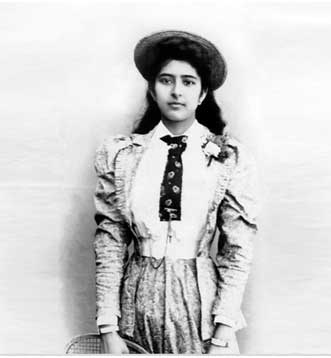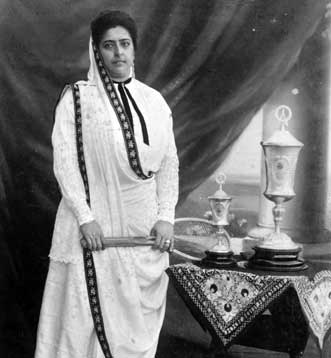Lady Meherbai Tata — a true champion for women
 |
| Meherbai and Dorabji Tata after their wedding on February 14, 1898 |
Meherbai was born in Bombay on October 10, 1879. Her father, Hormusji J. Bhabha, was one of the first Parsis to go to England to pursue higher education. When her family moved to Bangalore, she was educated at the Bishop Cotton School. In 1884, her father was appointed as the principal of Maharaja’s College, Mysore. Under his guidance, Mehri excelled in English and Latin, and attended college for science classes. She successfully passed her matriculation at the age of 16, thereafter pursuing her studies in her father’s extensive library. A missionary lady was enlisted to supervise her reading in English Literature and give her music lessons. The young Mehri soon became an accomplished pianist sought after at every public concert in Mysore.
 |
| Meherbai started playing tennis when very young |
On February 14, 1898, the beautiful Mehri married Dorabji Tata, the eldest son of Jamsetji N. Tata. Dorabji is known for having gifted his newly-wed bride the larger-than-life 245.35 carat Jubilee diamond in 1900, which she proudly wore when attending important public functions. Later in the 1920s, however, Lady Meherbai generously pledged her diamond to raise funds for Tata Iron and Steel Company Ltd. (TISCO), which was facing a great financial crisis at the time.
Frequent travels with Dorabji across the world opened up new avenues for self-education which Mehri greatly enjoyed. Games, especially tennis, held a deep fascination for her. She played in several tournaments and won over 60 prizes. She shared Dorabji’s love for sports and won the ‘Triple Crown’ in the Western India Tennis Tournament. Together, they achieved numerous victories at the All-India Championships, Wimbledon, Kissengen, Baden-Baden, and on almost every prestigious tennis court in India. Her pride in the national dress, the ‘saree’, garnered admiration from many spectators. She was also an exceptional horse rider and drove her own motor car.
 |
| Meherbai with her tennis trophies |
Many women in similar circumstances might have been content to bask in the triumphs of high society. Meherbai, however, was made of different stuff. She received a liberal education, an unusual feat for those times, which she put to good use throughout her life. She was sensitive to the plight of women in India and was one of the founders of the Bombay Presidency Women’s Council and the National Council of Women.
In 1929, the Child Marriage Restraint Act, commonly referred to as the Sarda Act, was enacted. Much of the credit goes to the pioneers of the women’s movement in India, including Lady Meherbai Tata. Not only was Lady Tata consulted on the Sarda Act, but she also actively campaigned for it in India and abroad.
| “...I always say Indians can never be a great nation until their women are given the necessary training and full scope and power to do all the good they can...” — Lady Meherbai Tata in Lady Tata: A Book of Remembrance, 1932 |
She also ardently campaigned for the advancement of women’s education, against the purdah system, and against the practice of untouchability. Her husband Dorab wholeheartedly supported her quest to advance the cause of women’s education, even encouraging her to take charge of the local school and transform it into a model institution. Together, they brought in an expert from England to conduct a survey of the state of female education in India. This extensive survey took over a year and the resulting book, which documented the findings, became, for many years, the handbook provided by the Board of Education in Whitehall to all women inspectors before they made their way to India to promote higher education for girls.
 |
| Meherbai at the International Council for Women in 1929 |
Meherbai played an active role during the war by mobilising contributions. She was also a dedicated member of the Indian Red Cross Society, to which she contributed generously. In 1919, her invaluable services both to the war efforts and to women were acknowledged when King George V honoured her as a Commander of the British Empire.
Years later, in 1930, she was appointed as the Chairman of the Reception Committee for the All India Women’s Conference held in Bombay. Her opening address gave a comprehensive view of all the significant issues affecting the well-being of Indian women, both directly and indirectly.
Suffering from leukaemia during the final stages of her life, Lady Tata was admitted to a nursing home in Ruthin, North Wales, where she passed away on June 18, 1931. Her ashes were interred at Brookwood Cemetery. In 1932, Sir Dorabji Tata established the Lady Tata Memorial Trust in memory of his wife Meherbai. The Trust funds scientific research in blood-related diseases, with a special focus on leukaemia.
As indicated in her will, Sir Dorabji Tata also established another trust, the Lady Meherbai D. Tata Education Trust, dedicated to empowering young Indian women through higher education. It offers scholarships to female graduates from recognised Indian universities to pursue higher studies abroad.
Source : Tata Central Archives
Photos courtesy: Tata Central Archives
Quick links
About Jamsetji N. Tata
About Sir Dorabji Tata | Sir Dorabji and Lady Meherbai Tata: A Partnership of Vision and Service
About JRD Tata
About Sir Ratan Tata
About Lady Navajbai Tata
About Ratan Tata
Anecdotes
